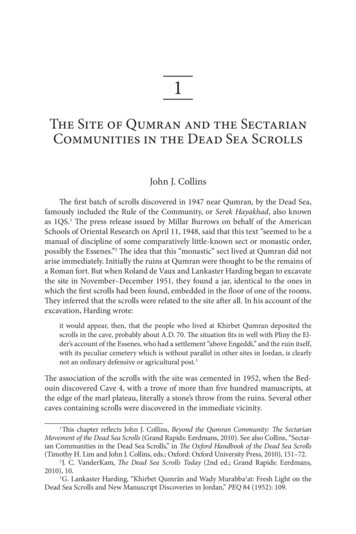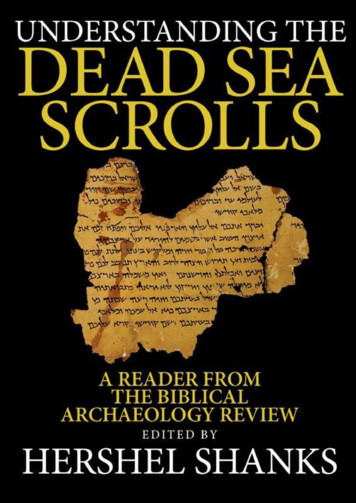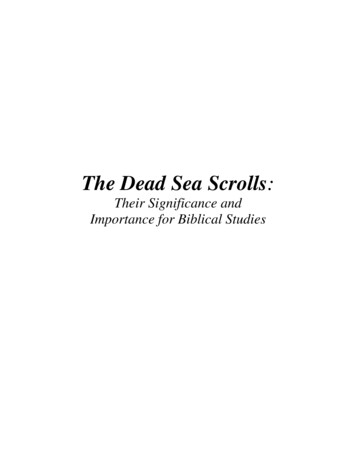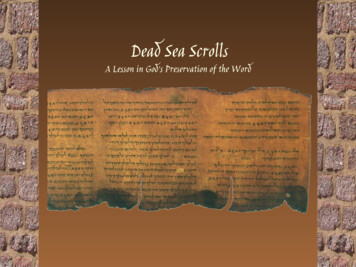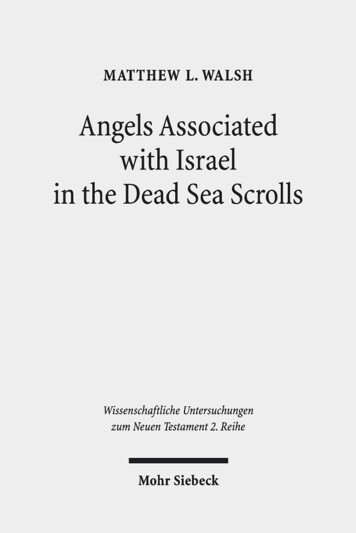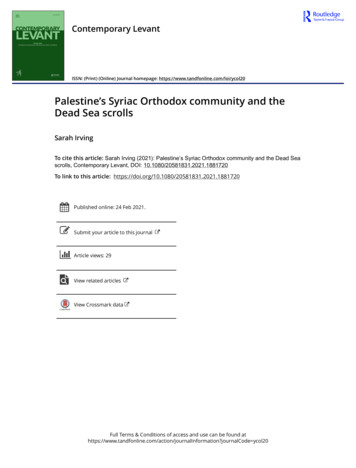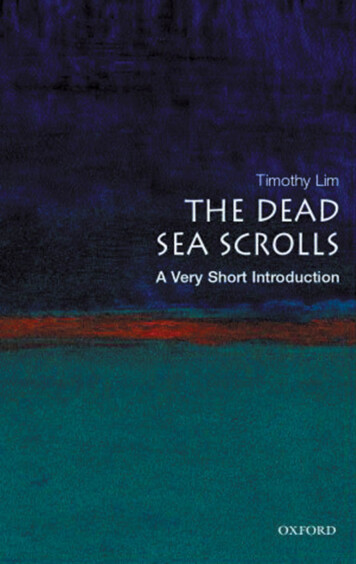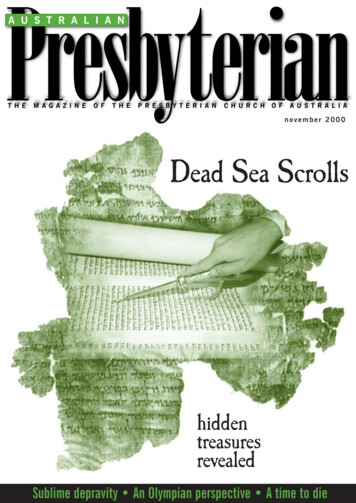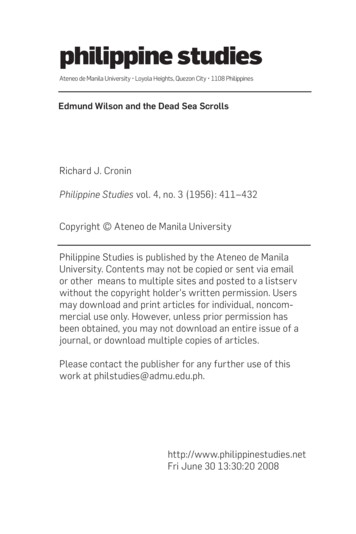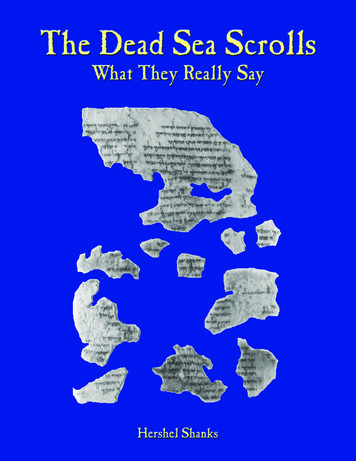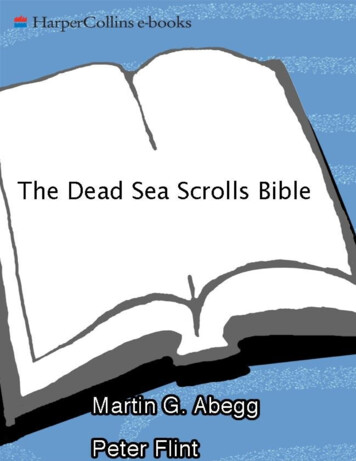
Transcription
THE DEAD SEA SCROLLSBIBLEThe Oldest Known Bible Translated for the First Time into EnglishMARTIN ABEGG, JR., PETER FLINT, AND EUGENE ULRICH
DEDICATIONFor our children: Stephanie and JenniferClaire, Amy, Abigail, and JasonSabrina, Ivan, Meg, and Laura
ContentsTITLE PAGEDEDICATIONINTRODUCTIONHOW TO READ THIS AHEZEKIELTHE BOOK OF THE TWELVE MINOR KZEPHANIAHHAGGAIZECHARIAHMALACHI1 ENOCHDANIEL
OTHER BOOKSPSALMSJOBPROVERBSBEN SIRA (SIRACH)RUTHTHE SONG OF SONGS (CANTICLES)QOHELET (ECCLESIASTES)LAMENTATIONSTHE EPISTLE OF APHYENDNOTESADVANCE INTERNATIONAL ACCLAIMCOPYRIGHTABOUT THE PUBLISHER
INTRODUCTIONAt the time of Jesus and rabbi Hillel—the origins of Christianity and rabbinic Judaism—there was, andthere was not, a “Bible.” This critical period, and the nature of the Bible in that period, have been freshlyilluminated by the biblical Dead Sea Scrolls.There was a Bible in the sense that there were certain sacred books widely recognized by Jews asfoundational to their religion and supremely authoritative for religious practice. There was not, however,a Bible in the sense that the leaders of the general Jewish community had specifically considered,debated, and definitively decided the full range of which books were supremely and permanentlyauthoritative and which ones—no matter how sublime, useful, or beloved—were not. The collection orcollections of the Scriptures varied from group to group and from time to time. All Jews would haverecognized “the Law” (the Torah) and most would have recognized “the Prophets” as belonging to thatcollection. Such a recognition is attested by references in the New Testament to the “Law and theProphets” (Matt 7:12; Luke 16:16; and Rom 3:21). But the exact contents of “the Prophets” may not havebeen the same for all, and the status of other books beyond “the Law and the Prophets” was neither clearnor widely accepted. The notion of a wider collection of Scriptures that extended beyond the Law andProphets is suggested by an intriguing passage in Luke 24, which says that “everything written about me[i.e., Jesus] in the Law of Moses, in the Prophets, and in the Psalms must be fulfilled” (vs. 44).The Dead Sea Scrolls help us see the state of affairs more clearly from an on-the-spot perspective.“The Bible,” or more accurately then, “the Scriptures,” would have been a collection of numerousseparate scrolls, each containing usually only one or two books. There is indeed persuasive evidence thatcertain books were considered “Scripture.” But there is little evidence that people were seriously askingthe question yet about the extent or the limits of the collection—the crucial question for a “Bible” or“canon”—which books are in and which books are outside this most sacred collection.Thus, The Dead Sea Scrolls Scriptures may be a more historically accurate title for this volume. Atany rate, it presents the remains of the books for which there is good evidence that Jews at that timeviewed them as Sacred Scripture.The “Bibles” Used TodayThe word “Bible” has different meanings for different people and groups. The most obvious difference incontent is between the Bible of Judaism (i.e., the Hebrew Bible or Old Testament) and that ofChristianity, which contains both the Old and New Testaments. The Dead Sea Scrolls Bible does notinclude any New Testament books for one simple reason: by the time the vast majority of the scrolls hadbeen copied (in 68 CE), the New Testament was only beginning to be written. Not surprisingly, then, thereare no copies of New Testament books among the scrolls.The list of books included in a Bible is termed a “canon.” There are three main canons in the differentBibles used today (see Figure 1):1. The Jewish Bible (or Tanak) contains twenty-four books in three sections: the Torah, theProphets, and the Writings.2. The Protestant Old Testament contains the same books as the Tanak, but in four sections and in adifferent order: the Pentateuch, the Historical Books, the Poetical Books, and the Prophets. Inaddition, the Protestant canon contains thirty-nine books, not twenty-four, because it counts
separately several books that comprise single books in the Jewish Bible. For example, the one Bookof the Twelve Minor Prophets in the Jewish canon becomes the twelve books of the Minor Prophetsin the Protestant Bible.3. The Roman Catholic Old Testament contains exactly the same four divisions and thirty-nine booksas the Protestant Bible, but also includes further writings. Seven of these are entire books (Tobit,Judith, 1 and 2 Maccabees, Wisdom of Solomon, Ecclesiasticus, and Baruch [which includes theLetter of Jeremiah]); the others are sections added to Esther (the Additions to Esther) and to Daniel(the Prayer of Azariah, Song of the Three Young Men, Susanna, and Bel and the Dragon). ForCatholics, these additional writings are part of the Bible and are thus known as the“deuterocanonical books” (that is, a second group of canonical books). However, Jews and mostProtestants do not view these writings as Scripture, labeling them the “Apocrypha” (plural of“Apocryphon”), which means “hidden books.”Some scholars believe that these books are not in the Jewish and Protestant canons because they arelater than most other biblical books (Daniel being an exception), while others point to their supposedsecular or unorthodox content as the reason for exclusion. The real explanation, however, is morecomplicated and goes back to two ancient Bibles. Early Christians accepted the Greek Septuagint, whichcontains these additional books, as their Old Testament, while early Rabbis finalized the list of books forthe Hebrew Bible in the second century CE. It is these two early collections (the shorter Hebrew one andthe longer Greek one) that determine which books are included in the Bibles used by modern Jews,Protestants, and Catholics. Jews, followed by Protestants, regard the shorter collection as Scripture,whereas Catholics accept a larger canon that includes apocryphal/deuterocanonical writings found in theSeptuagint.Figure 1: Jewish, Protestant, and Roman Catholic Canons of the Old Testament
Three Old BiblesAllmodern Bibles are translations of older texts. The Scriptures used by most readers of this book(whether Jewish, Protestant, or Roman Catholic) are based on much older manuscripts that have beentranslated into English. The three most important of these older Bibles are known as the “Masoretic Text”(MT), the “Septuagint” (LXX), and the “Samaritan Pentateuch” (SP). Scholars believe that the books inthese three texts are from pre-Christian times, but unfortunately no really early manuscripts wereavailable before the discovery of the Dead Sea Scrolls. Translations were made from the oldest availablemanuscripts, most of them medieval, in the belief that these late documents were accurate copies of farmore ancient texts.
The Masoretic TextAlmost all modern English translations of the Old Testament are based on a single manuscript, theLeningrad Codex, which was copied in 1008 CE and is our earliest complete copy of the Masoretic (orRabbinic) Text of the Hebrew Bible. The Leningrad Codex is used by most biblical scholars in itspublished edition, Biblia Hebraica Stuttgartensia (or the earlier Biblia Hebraica).Another important manuscript is the Aleppo Codex, which forms the basis of a new edition of theHebrew Bible currently being produced at the Hebrew University in Jerusalem. This manuscript wascopied in about 925 CE and is thus earlier than the Leningrad Codex; however, a substantial part has beenlost, which means that for some books the Hebrew University project must rely on the Leningrad Codexand other Hebrew manuscripts.Both the Leningrad Codex and the Aleppo Codex are part of what is known as the “Masoretic Text.”This term is quite complicated, since it covers many manuscripts rather than a single one; “MasoreticGroup” or “Masoretic Family” would thus be a more accurate name. Masoretic manuscripts—includingthe Leningrad Codex and the Aleppo Codex—contain the books of the Hebrew Bible in the threefoldarrangement that was developed by the Rabbis and is found in modern Jewish Bibles: the Torah, theProphets, and the Writings (though the specific order of books sometimes varies between manuscripts).This form of the Old Testament text now found in the Masoretic Text grew and was finalized in threeperiods, or stages. The first stage originated among Babylonian Jews, the Pharisees, or “temple circles” andended with the destruction of the Temple in 70 CE (or perhaps with the end of the SecondJewish Revolt in 135 CE). The second stage extended from the destruction of the Temple until the eighth century CE andwas characterized by more and more textual consistency as rabbinic scholars sought tostandardize the text of the Hebrew Bible. The third stage extended from the eighth century until the end of the Middle Ages and wascharacterized by almost complete textual uniformity. During this period, a group of Jewishscholars known as the Masoretes set out to produce a standard text of the Hebrew Bible—onethat in their eyes would be true to the Scriptures revealed by God in ancient times. Since theancient text consisted only of Hebrew consonants without any vowels (see Figure 2), manyreadings were open to diverse meanings (compare dg in English, which could be dig, dog, ordug, depending on which vowel is used). The Masoretes’ solution was to add vowels, accents,and Masoretic notes (see Figure 3), which required fixed meanings for groups of consonants(for example, only dig, not dog or dug). As a result, the Masoretic Text became almostcompletely standardized during this time. It is this standardized form of the Hebrew Bible thatis found in the Leningrad Codex and the Aleppo Codex, and upon which the Old Testaments ofmost English Bibles are based.Because the Masoretic Text has become the Bible of Judaism and is the main text of the Old Testamentused by scholars and Bible translators, its relationship to the biblical Dead Sea Scrolls is an importantissue. In the translation presented in this book, all readings from the scrolls have therefore been carefullycompared with the Masoretic Text, with any differences (or “variants”) signaled by the use of italics.The SeptuagintThe Septuagint is the ancient Greek version of the Hebrew Scriptures or Old Testament, translated by anumber of different Jewish scholars over the course of the third, second, and first centuries BCE. The
oldest manuscripts of the Septuagint, which are very fragmentary, include John Rylands Papyrus 458(second century BCE) and Papyrus Fouad 266 (about 100 BCE). Complete (or almost complete)manuscripts exist as well: Codex Sinaiticus (fourth century), Codex Vaticanus (fourth century), and CodexAlexandrinus (fifth century).Figure 2: Psalm 1 in Its Ancient FormatThe text contains no verse numbers, vowels, or other signs.Figure 3: Psalm 1 in the Standardized Masoretic FormatHere is the same text with verse numbers and the Masoretic vowels, marks, and accents.But why was a Greek translation of the Hebrew Scriptures necessary? Following the conquests ofAlexander the Great in the late fourth century BCE, Greek was increasingly used in the Ancient Near East,including Palestine, and numerous Jews and other peoples emigrated to lands such as Egypt. Eventually,more and more Jews adopted Greek as their first language and became less and less fluent in Hebrew.
For such Hellenized Jews to maintain and understand their religion, a translation of the HebrewScriptures into Greek became increasingly necessary.The translation was begun in the third century BCE in Alexandria (Egypt), one of the centers ofHellenistic Judaism. According to a delightful legend in the Letter of Aristeas, seventy-two scholars, sixfrom each of the twelve Israelite tribes, were brought from Jerusalem to translate the Pentateuch intoGreek during the reign of Ptolemy Philadelphus (285–247 BCE). The precise number of scholars wasrounded off to seventy, from which comes the term Septuagint (meaning “seventy” in Latin). Eventually,the “Septuagint” grew to embrace Greek translations of all the books of the Hebrew Bible, translations ofsome books excluded from the Hebrew Bible, and even a few sacred Jewish books originally composedin Greek.The Septuagint is important for several reasons. First, almost all the books it contains were translatedfrom an earlier Hebrew or Aramaic form (though a few books, such as 2 Maccabees, were originallycomposed in Greek). This means that the Septuagint gives readers a window on an ancient Hebrew formof the Old Testament that is earlier than the time of Jesus. Second, the Septuagint sometimes offersstriking evidence of different ancient forms of biblical books (for example, Jeremiah is about 13 percentshorter in the Greek than in the Masoretic Text) as well as different ancient readings in specific passages.Third, because the Septuagint was the Bible of Hellenistic Judaism, it offers important insights into howGreek-speaking Jews used and understood Scripture. Fourth, since the Septuagint is quoted in the NewTestament and was used by early Christian authors, it constitutes the Bible of the early church and helps toexplain early Christian exegesis of Scripture. Finally, the Septuagint contains the books of the OldTestament in the fourfold arrangement that is found in modern Christian Bibles: Pentateuch, HistoricalBooks, Poetical Books, and Prophets (though the specific order of books sometimes varies betweenSeptuagint manuscripts). It is from the Septuagint that most modern Bibles have adopted this grouping andthat Catholic Bibles have included the deuterocanonical books (or Apocrypha).Because of the Septuagint’s importance as an ancient translation, the list of variant readings in thefootnotes of this book will often indicate whether or not the Septuagint agrees with readings found in theDead Sea Scrolls, in the Masoretic Text, and in the Samaritan Pentateuch.The Samaritan PentateuchThe third ancient Bible is known as the Samaritan Pentateuch; as its name implies, it contains only the fiveBooks of Moses. The Samaritan Pentateuch was finalized as a collection before the Christian era and hasbeen used by the Samaritans, a small branch of Judaism, ever since. A small but active Samaritancommunity still exists, using this Bible and practicing its own customs and ceremonies.The Discovery, Contents, and Origin of the Dead Sea ScrollsThis book provides only a brief overview of the discovery of the Dead Sea Scrolls and their contents,since detailed information is readily available elsewhere. The term “Dead Sea Scrolls” refers to ancientmanuscripts discovered at sites in the Judean Desert in the vicinity of the Dead Sea. The most importantand famous of these sites is Qumran, but scrolls were found at several other sites as well.Discovery of the ScrollsBetween 1947 and 1956, eleven caves were discovered in the region of Khirbet Qumran, about a mile
inland from the western shore of the Dead Sea and approximately fourteen miles east of Jerusalem. Theeleven caves yielded various artifacts (especially pottery) and manuscripts written in Hebrew, Aramaic,and Greek, the three languages of the Bible. (The Hebrew Bible is written in Hebrew and Aramaic; theSeptuagint and New Testament in Greek.)In addition to the finds at Khirbet Qumran, several manuscripts were discovered at other locations inthe vicinity of the Dead Sea, especially Wadi Murabba‘ât (1951–52), Nah.al H.ever (1951–52 and 1960–61), and Masada (1963–65).Description and Contents of the ScrollsAt Qumran, nearly 900 manuscripts were found in some twenty-five thousand pieces, with many no biggerthan a postage stamp. A few scrolls are well preserved, such as the Great Isaiah Scroll from Cave 1(1QIsa ) and the Great Psalms Scroll from Cave 11 (11QPs ). Unfortunately, however, most of the scrollsare very fragmentary. The earliest manuscripts date from about 250 BC, while the latest ones were copiedshortly before the destruction of the Qumran site by the Romans in 68 CE. Approximately forty-five moremanuscripts were discovered at the other sites: about fifteen at Wadi Murabba‘ât, eighteen at Nah.alH.ever, and twelve at Masada.Scholars divide the Dead Sea Scrolls into two categories: the “biblical” manuscripts and the“nonbiblical” ones. Of course, this distinction is from our later viewpoint (and not necessarily that of theancient copyists), but it is useful for purposes of organization and editing. The nonbiblical scrolls arealready available in English translation: for example, The Dead Sea Scrolls, by Michael Wise, MartinAbegg, Jr., and Edward Cook (San Francisco: HarperSanFrancisco, 1996). But until now the biblicalscrolls have never been translated into any modern language; The Dead Sea Scrolls Bible makes thismaterial available in English for the first time.Some 215 manuscripts from Qumran, plus twelve more from the other sites, are classified as biblicalscrolls, since they contain material found in the canonical Hebrew Bible. Since these manuscripts containthe texts from which The Dead Sea Scrolls Bible has been translated, they will be discussed in greaterdetail later in this Introduction (see section headed “The Biblical Scrolls”).A few brief comments on the nonbiblical scrolls will be helpful at this point. There are approximately670 of these scrolls, which can be divided into five groups: (1) rules and regulations (for example, theCommunity Rule); (2) poetic and wisdom texts (for example, the Hodayot or Thanksgiving Psalms); (3)reworked or rewritten Scripture (for example, the Genesis Apocryphon); (4) commentaries or pesharim(for example, the Pesher on Habakkuk); and (5) miscellaneous writings (for example, the CopperScroll).The nonbiblical scrolls can be very helpful for understanding Scripture at Qumran, since they oftenquote from or refer to biblical books and passages. These manuscripts also offer valuable insights intohow Scripture was used and interpreted by the Essenes and other Jewish groups in the last few centuriesBCE and up to the destruction of the Qumran community in 68 CE. Many of these documents are also ofdirect relevance to early Judaism and emerging Christianity, since they anticipate or confirm numerousideas and teachings found in the New Testament and in later rabbinic writings (the Mishnah and Talmud).aaOrigin of the ScrollsMost scholars agree that the group who lived at the Qumran site from about 150 BCE to 68 CE was a strictbranch of the Essenes. Together with the Pharisees and Sadducees, the Essenes formed the three maindivisions (or “denominations”) of Judaism at the time of Jesus; they were previously known to us in
works of the Hellenistic Jewish writers Josephus and Philo, and of Latin authors such as Pliny the Elder.It is also generally agreed that these Essenes deposited many scrolls in most of the Qumran caves.However, a smaller number of scholars disagree with these points. It has been suggested, for instance,that the members of the Qumran community were not Essenes at all but Sadducees, or that the site was infact a military fortress or a winter resort.These issues are of great importance for understanding the nonbiblical scrolls, since scholarsdistinguish between those manuscripts that were composed at Qumran and those that came to the Qumran“library” from elsewhere. Many scholars refer to the writings composed at Qumran as the “sectarian”scrolls, which is helpful for purposes of identification—but is also confusing. In modern Judaism andChristianity, a “sect” is usually an offshoot of a larger religion and is frequently viewed as eccentric ordeviant with respect to beliefs. But both scholars and laypeople would do well to remember that duringthe entire Qumran period, the Pharisees and Sadducees were as much “sects” as the Essenes were! It wasonly from the second century CE onward that one type of Judaism—that of the Pharisees and theirdescendants, the Rabbis—became standard for the Jewish people as a whole.These issues are of less importance with respect to the biblical scrolls. For one thing, all scholarsagree that none of the biblical texts (such as Genesis or Isaiah) was actually composed at Qumran; on thecontrary, they all originated before the Qumran period. It is also widely held that many or most of thesemanuscripts were brought to Qumran from outside and were thus copied elsewhere. This means that thevalue of most biblical scrolls lies not in establishing precisely where they were written or copied, butrather in studying the textual forms they contain.Several distinctive biblical scrolls, however, were copied at Qumran, which raises some interestingissues. For example, it is likely that 4QSam was copied there, since it was copied by the same scribewho penned the main manuscript of the Community Rule (1QS). This offers helpful insights into scribalhabits among the Qumran community. Another issue is whether or not such Qumran scribes modified thetext they were copying in order to produce distinctive Qumranic readings of the biblical text. Theevidence to date suggests that such alteration did not take place.cThe Biblical ScrollsThe Dead Sea Scrolls include more than 225 “biblical” manuscripts, about 215 of which were found atQumran. Unfortunately, with a few exceptions (such as 1QIsa and 11QPs ), almost all these manuscriptsare in fragmentary form. Parts of every book of the Jewish and Protestant Old Testament are included,with the exception of Esther and Nehemiah. In addition, some other books now included in RomanCatholic Bibles were found at Qumran: Tobit, Ben Sira (also known as Sirach or Ecclesiasticus), and theLetter of Jeremiah (also known as Baruch 6). In terms of the Catholic canon, then, the total of biblicalscrolls would be somewhat higher, at about 235 (about 222 from Qumran). It is also most likely that theQumran community viewed the books of 1 Enoch and Jubilees as Scripture.What was the “shape” of the Bible at Qumran? In other words, in what order did the books viewed asscripture at Qumran most likely occur? While most modern Bibles follow the order of the Christian OldTestament canon in four divisions (Pentateuch, Historical Books, Poetry, and Prophets), the ancientevidence from the scrolls suggests the following order: the Books of Moses, the Prophets, and the Psalms.A key passage that suggests this order can be found in the Halakhic Letter from Qumran (4QMMT): “Andwe have also written to you so that you may have discernment in the book of Moses and in the books ofthe Prophets and in Dav[id].” (It is interesting to note that Jesus uses almost the same terminology in Luke24:44: “. . . that everything written about me in the Law of Moses, in the Prophets, and in the Psalms mustbe fulfilled.”)aa
Which of these many biblical books are represented most among the Qumran scrolls? In other words,which writings were most popular for the Qumran community? The following list emerges: (1) thePsalms, with a total of thirty-seven manuscripts, (2) Deuteronomy (with thirty manuscripts), and (3) Isaiah(with twenty-one manuscripts). Although many scrolls have been lost, these statistics serve to indicatewhich books were most frequently used among the Qumran community. If we count the number of times anOld Testament passage is quoted or referred to in the New Testament, the same three books turn up most:the Psalms (cited about sixty-eight times), Isaiah (sixty-three times), and Deuteronomy (thirty-nine times).How This Book Was CompiledThisbook, containing the first translation of the biblical scrolls into any language, was compiledaccording to seven principles:1. Maintaining the Historical Order of Books. The order of books in The Dead Sea Scrolls Biblecorresponds to the ancient evidence as far as can be determined: the Books of Moses (includingJubilees), the Prophets (including 1 Enoch and Daniel), and the Psalms and remaining books(including Ben Sira, the Epistle of Jeremiah, and Tobit).2. Including Introductory Material. The translation of each book is preceded by an introduction thatincludes a brief description of the relevant scrolls, the dates of at least some of these manuscripts,and the textual form or forms of the book in the scrolls.3. Depending on Large Manuscripts. Among all the biblical scrolls, very large manuscripts arepreserved for only two books: Isaiah and Psalms. Since a scroll of the entire book of Isaiah wasfound in a sealed jar in Cave 1 virtually intact, the translation of Isaiah presented here is of thiscomplete manuscript (1QIsa ). Similarly, another large, continuous scroll of the Psalms (11QPs )was found in Cave 11. The translation of Psalms 101 to 151, in a different order than that found intraditional Bibles, is mostly from this manuscript.4. Integrating Material from Several Manuscripts. Unfortunately, for all the other biblical books,only fragments survive (some quite substantial, but most of them small). Thus for these books thetranslation is necessarily a patchwork of the remaining pieces from different scrolls. Since the text isconstantly interrupted by the breaking off of the fragments, intervening text is inserted to providecontext; this material is taken from our traditional Bible (based on the Masoretic Text). Thepreserved text is presented in regular type, with nonextant text supplied in square brackets. If onlypart of a verse or word is preserved in one scroll and another part can be found in a different scroll,the editors have combined the fragments to supply as much of the surviving text as possible.For example, in one scroll (4QGen ), we have only the following words preserved forGenesis 1:1: “In the beginning Go[] made [ ].” If this were our only manuscript containingthis verse, The Dead Sea Scrolls Bible would read: “In the beginning Go[d] made [theheavens and the earth],” with the supplied text in square brackets. Fortunately, however,another scroll (4QGen ) also contains part of this verse—“In the beginn[ ] God [ ] theheavens and the earth”—a fragment that includes material missing from 4QGen . So whenthe preserved letters from the two scrolls are combined, the translation is as follows: “Inthe beginning God made the heavens and the earth.”5. Signaling Variant Readings. When the translation of a passage in the scrolls differs from thetraditional biblical text (the Masoretic Text) or from any other Dead Sea Scroll, it is printed initalics to alert the reader. In order to emphasize the distinctive readings found in some scrolls, theaabgb
editors have presented these variant readings in the main translation as far as possible (except forIsaiah and Psalms 101 to 151, where the translation is from a single large scroll, as explainedabove). Any alternative readings that are found in the scrolls, the Masoretic Text (MT), theSeptuagint (LXX), or the Samaritan Pentateuch (SP) are listed in the footnotes. Thus the reader isable to compare all the different readings for a given word or passage on the same page.For example, near the end of Daniel 7:1 the traditional text says of King Belshazzar,“then he wrote down the dream, he related the sum of the words,” which is awkward. Theonly scroll that preserves this verse is 4QDan , which simply reads “then he wrote downthe dream.” Accordingly, The Dead Sea Scrolls Bible translation reads “then he wrotedown the dream.” The corresponding footnote (which is indicated by the superscripted 3)reads:b34QDan and probably LXX. the dream, he related the sum of the words MT LXX .bmssThis shows that the translation is found in 4QDan and most likely the originalSeptuagint, while the longer reading is found in the Masoretic Text and some Septuagintmanuscripts.6. Highlighting Interesting or Important Readings. The Dead Sea Scrolls Bible includesapocryphal books, new Psalms, previously unknown passages, and hundreds of individual readingsthat are significant or interesting for our understanding of Scripture. The translators highlight some ofthis new or interesting material with the use of italicized comments. One example is found beforeIsaiah 29:5:b Several possibilities exist for the multitude referred to in Isaiah 29:5. Is the best reading “yourstrangers,” mentioned in the Masoretic text, “the ungodly,” referred to in the Septuagint, or“your enemies,” as found in 1QIsaa? A solution is offered by the parallel phrase later in theverse “and the multitude of the ruthless ones,” which suggests that the reading in 1QIsaa is thepreferred one. “Your enemies” (or “Your foes”) is found in several modern translations,including the Revised Standard Version, the New Revised Standard Version, and the NewInternational Version.Although there are scores of such interesting readings, in order to produce The DeadSea Scrolls Bible in one volume we were limited to highlighting only a selection of keyreadings in this way. But for the reader who seeks further examples, this book presents therich variety of readings found in all the biblical scrolls in a complete fashion, whether initalicized form in the main text, or in the footnotes below.7. Emphasizing Accuracy over Style. Since there are numerous aspects involved in the translation ofa Bible, it usually takes a large team of translators more than a decade to produce one. In order tomake The Dead Sea Scrolls Bible available in a reasonable amount of time, the main concern of thetranslators was to represent faithfully the text as found in the scrolls. We have not attempted toachieve overall stylistic consistency for the whole volume, since that would have required a fargreater amount of time. Two points, however, should be emphasized. First, we have been consistentin translating the Divine Name by following the practice of the Revised Standard
The Dead Sea Scrolls help us see the state of affairs more clearly from an on-the-spot perspective. "The Bible," or more accurately then, "the Scriptures," would have been a collection of numerous separate scrolls, each containing usually only one or two books. There is indeed persuasive evidence that
